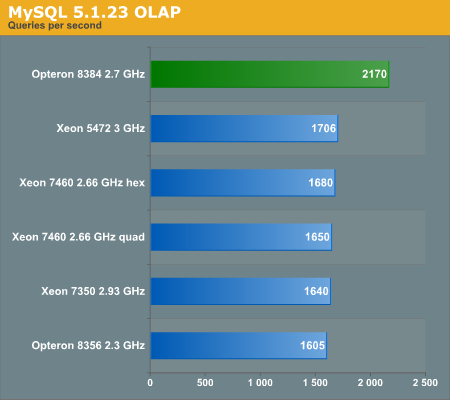The Best Server CPUs Compared, Part 1
by Johan De Gelas on December 22, 2008 10:00 PM EST- Posted in
- IT Computing
Decision Support Benchmark: 64-bit MySQL (Linux SUSE SLES 10 SP2 64-bit)
Decision support databases are completely different from the I/O dominated OLTP databases. Large select statements have to go through almost the entire database, so the CPU and especially the memory subsystem get a lot more work to do. We test with an e-commerce site's database on MySQL 5.1.23 using the INNODB database engine. You can find out more about our MySQL testing here. We tested with only one CPU as MySQL has trouble scaling above four cores.

Please note that these results cannot be compared with our earlier MySQL results, as the version is different as is the my.cnf config file too. The Opteron 8484 "Shanghai" simply annihilates the competition. Our VTune profiling on one of the Xeons shows us that MySQL is very sensitive to the latency of the cache and memory subsystem, so the latest Opteron has a great advantage compared to the older 65nm generation, as latency has been reduced in the L3 cache and memory controller. This results in a 35% boost, much more than the 17% clock speed advantage.










29 Comments
View All Comments
zpdixon42 - Wednesday, December 24, 2008 - link
DDR2-1067: oh, you are right. I was thinking of Deneb.Yes performance/dollar depends on the application you are running, so what I am suggesting more precisely is that you compute some perf/$ metric for every benchmark you run. And even if the CPU price is less negligible compared to the rest of the server components, it is always interesting to look both at absolute perf and perf/$ rather than just absolute perf.
denka - Wednesday, December 24, 2008 - link
32-bit? 1.5Gb SGA? This is really ridiculous. Your tests should be bottlenecked by IOJohanAnandtech - Wednesday, December 24, 2008 - link
I forgot to mention that the database created is slightly larger than 1 GB. And we wouldn't be able to get >80% CPU load if we were bottlenecked by I/Odenka - Wednesday, December 24, 2008 - link
You are right, this is a smallish database. By the way, when you report CPU utilization, would you take IOWait separate from CPU used? If taken together (which was not clear) it is possible to get 100% CPU utilization out of which 90% will be IOWait :)denka - Wednesday, December 24, 2008 - link
Not to be negative: excellent article, by the waymkruer - Tuesday, December 23, 2008 - link
If/When AMD does release the Istanbul (k10.5 6-core), The Nehalem will again be relegated to second place for most HPC.Exar3342 - Wednesday, December 24, 2008 - link
Yeah, by that time we will have 8-core Sandy Bridge 32nm chips from Intel...Amiga500 - Tuesday, December 23, 2008 - link
I guess the key battleground will be Shanghai versus Nehalem in the virtualised server space...AMD need their optimisations to shine through.
Its entirely understandable that you could not conduct virtualisation tests on the Nehalem platform, but unfortunate from the point of view that it may decide whether Shanghai is a success or failure over its life as a whole. As always, time is the great enemy! :-)
JohanAnandtech - Tuesday, December 23, 2008 - link
"you could not conduct virtualisation tests on the Nehalem platform"Yes. At the moment we have only 3 GB of DDR-3 1066. So that would make pretty poor Virtualization benches indeed.
"unfortunate from the point of view that it may decide whether Shanghai is a success or failure"
Personally, I think this might still be one of Shanghai strong points. Virtualization is about memory bandwidth, cache size and TLBs. Shanghai can't beat Nehalem's BW, but when it comes to TLB size it can make up a bit.
VooDooAddict - Tuesday, December 23, 2008 - link
With the VMWare benchmark, it is really just a measure of the CPU / Memory. Unless you are running applications with very small datasets where everything fits into RAM, the primary bottlenck I've run into is the storage system. I find it much better to focus your hardware funds on the storage system and use the company standard hardware for server platform.This isn't to say the bench isn't useful. Just wanted to let people know not to base your VMWare buildout soley on those numbers.